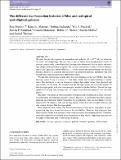Files in this item
The different star formation histories of blue and red spiral and elliptical galaxies
Item metadata
| dc.contributor.author | Tojeiro, Rita | |
| dc.contributor.author | Masters, Karen L. | |
| dc.contributor.author | Richards, Joshua | |
| dc.contributor.author | Percival, Will J. | |
| dc.contributor.author | Bamford, Steven P. | |
| dc.contributor.author | Maraston, Claudia | |
| dc.contributor.author | Nichol, Robert C. | |
| dc.contributor.author | Skibba, Ramin | |
| dc.contributor.author | Thomas, Daniel | |
| dc.date.accessioned | 2018-10-17T14:30:12Z | |
| dc.date.available | 2018-10-17T14:30:12Z | |
| dc.date.issued | 2013-06-11 | |
| dc.identifier | 171418500 | |
| dc.identifier | 2ab97ac3-7b62-4c17-9ab1-ee6c58f98fee | |
| dc.identifier | 84878503359 | |
| dc.identifier.citation | Tojeiro , R , Masters , K L , Richards , J , Percival , W J , Bamford , S P , Maraston , C , Nichol , R C , Skibba , R & Thomas , D 2013 , ' The different star formation histories of blue and red spiral and elliptical galaxies ' , Monthly Notices of the Royal Astronomical Society , vol. 432 , no. 1 , pp. 359-373 . https://doi.org/10.1093/mnras/stt484 | en |
| dc.identifier.issn | 0035-8711 | |
| dc.identifier.other | BibCode: 2013MNRAS.432..359T | |
| dc.identifier.uri | https://hdl.handle.net/10023/16261 | |
| dc.description.abstract | We study the spectral properties of intermediate mass galaxies (M* ∼ 1010.7 M⊙) as a function of colour and morphology. We use Galaxy Zoo to define three morphological classes of galaxies, namely early types (ellipticals), late-type (disc-dominated) face-on spirals and early-type (bulge-dominated) face-on spirals. We classify these galaxies as blue or red according to their Sloan Digital Sky Survey (SDSS) g − r colour and use the spectral fitting code Versatile Spectral Analyses to calculate time-resolved star formation histories, metallicity and total starlight dust extinction from their SDSS fibre spectra. We find that red late-type spirals show less star formation in the last 500 Myr than blue late-type spirals by up to a factor of 3, but share similar star formation histories at earlier times. This decline in recent star formation explains their redder colour: their chemical and dust content are the same. We postulate that red late-type spirals are recent descendants of blue late-type spirals, with their star formation curtailed in the last 500 Myr. The red late-type spirals are however still forming stars ≃17 times faster than red ellipticals over the same period. Red early-type spirals lie between red late-type spirals and red ellipticals in terms of recent-to-intermediate star formation and dust content. Therefore, it is plausible that these galaxies represent an evolutionary link between these two populations. They are more likely to evolve directly into red ellipticals than red late-type spirals, which show star formation histories and dust content closer to blue late-type spirals. Blue ellipticals show similar star formation histories as blue spirals (regardless of type), except that they have formed less stars in the last 100 Myr. However, blue ellipticals have different dust content, which peaks at lower extinction values than all spiral galaxies. Therefore, many blue ellipticals are unlikely to be descendants of blue spirals, suggesting there may not be single evolutionary path for this group of galaxies. | |
| dc.format.extent | 2258841 | |
| dc.language.iso | eng | |
| dc.relation.ispartof | Monthly Notices of the Royal Astronomical Society | en |
| dc.subject | Surveys | en |
| dc.subject | Galaxies: evolution | en |
| dc.subject | Galaxies: statistics | en |
| dc.subject | Galaxies: stellar content | en |
| dc.subject | QB Astronomy | en |
| dc.subject.lcc | QB | en |
| dc.title | The different star formation histories of blue and red spiral and elliptical galaxies | en |
| dc.type | Journal article | en |
| dc.contributor.institution | University of St Andrews. School of Physics and Astronomy | en |
| dc.identifier.doi | 10.1093/mnras/stt484 | |
| dc.description.status | Peer reviewed | en |
| dc.identifier.url | http://adsabs.harvard.edu/abs/2013MNRAS.432..359T | en |
This item appears in the following Collection(s)
Items in the St Andrews Research Repository are protected by copyright, with all rights reserved, unless otherwise indicated.

